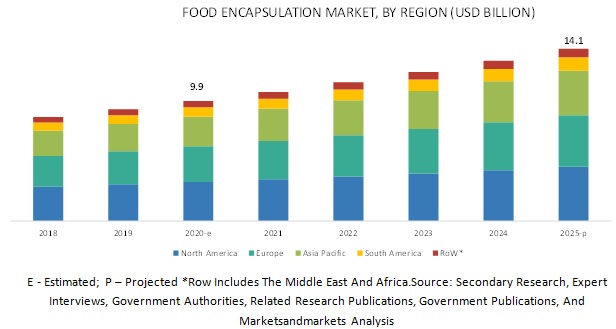The report “Food Encapsulation Market by Shell Material (Polysaccharides, Emulsifiers, Lipids, Proteins), Technology (Microencapsulation, Nanoencapsulation, Hybrid encapsulation), Application, Method, Core Phase, and Region – Global Forecast to 2025″ The global food encapsulation market size is projected to reach USD 14.1 billion by 2025, from USD 9.9 billion in 2020, recording a CAGR of 7.5% during the forecast period. This market is majorly driven by the rising demand for encapsulated flavors from convenience food manufacturers, and increasing demand for fortified food products.

Vitamins and minerals are the most common ingredients encapsulated for functional food and dietary supplements.
Vitamins are functional ingredients that are used in food owing to their specific nutritional properties for varied human body parts. Thus, a targeted and controlled release of vitamins often becomes important, when added as a food ingredient. Thus, encapsulation is majorly adopted for vitamins for its targeted effect. Following vitamins, there has been a growing trend in the encapsulation of flavors to achieve controlled and prolonged release of taste and fragrance of the ingredient.
Download PDF Brochure: https://www.marketsandmarkets.com/pdfdownloadNew.asp?id=68
The market for dietary supplements is projected to record the highest CAGR during the forecast period.
The demand for dietary supplements is on the rise in developed and developing countries among the millennial population. Vitamins, enzymes, and minerals are some of the major constituents of dietary supplements, which require targeted delivery. Also, industry experts foresee the adoption rate for dietary supplements to rise the highest in the coming five years.
Polysaccharides are the most preferred shell phase for food encapsulation.
The polysaccharides segment accounted for the largest market for shell material in 2018 and is projected to follow the same trend through 2025. Polysaccharides are a composition of repeating monosaccharide units connected by glycoside bonds. Polysaccharides are easily chemically modifiable and provide numerous textures and viscosities. Owing to their enormous molecular structure and ability to entrap bio-actives, polysaccharides are considered the most-suitable building blocks for delivery systems.
With the increasing demand for functional food, North America is estimated to dominate the global food encapsulation market in 2020.
The demand for functional food and dietary supplements has been high in the US and Western European countries. Consumers have been willing to bear the premium pricing of products in case of nutrient addition to the final product. Thus, ingredient manufacturers have been adopting technological ways to improve the quality of functional food and dietary supplement products. Thus, encapsulated food has been highly consumed in these regions. Also, the presence of key ingredient manufacturers has been high in North America, which is either providing encapsulated food as a part of their offering or in companies, which have been providing encapsulation as a service.
Make an Inquiry: https://www.marketsandmarkets.com/Enquiry_Before_BuyingNew.asp?id=68
Key players operating in this market include FrieslandCampina (Netherlands), DSM (Netherlands), Ingredion Incorporated (US), Kerry Group (Ireland), Cargill (US), Lycored Group (Israel), Balchem Corporation (US), Firmenich Incorporated (Switzerland), BASF SE (Germany), International Flavors and Fragrances Inc. (US), DuPont (US), Symrise AG (Germany), Sensient Technologies Corporation (US), Aveka Group (US), Advanced Bionutrition Corp (US), Encapsys (US), Tastetech Encapsulation Solutions (UK), Sphera Encapsulation (Italy), Clextral (France), and Vitasquare (Netherlands).

